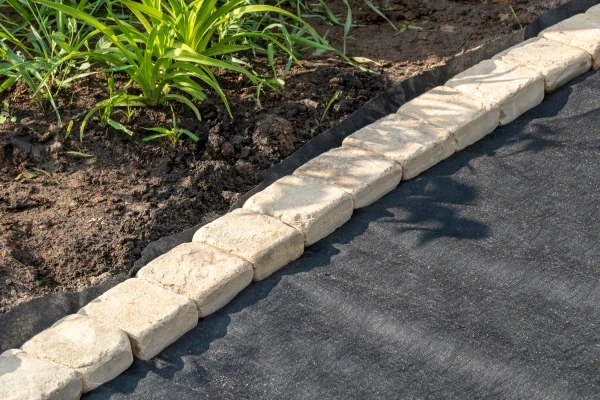How to Use Landscape Fabric

You may occasionally enjoy weekends in the garden clearing out weeds, but perhaps you’re looking for a more hands-off approach. Landscape fabric is an option that you can incorporate into your design to reduce the time and effort you spend managing weeds. Although not a miracle tool, it can help retain ground moisture, discourage weed growth, and add a measure of erosion control. By learning the ins and outs of landscape fabric, you can make caring for your garden easier on yourself.
Related Topic: What Are the Different Types of Mulch?
What Is Landscape Fabric?
Also known as weed fabric or weed block, landscape fabric comes in rolls and is made of woven fibres or unwoven material that blocks light from potential weeds underneath. While some fabrics allow water and nutrients to reach the soil, others do not. Likewise, some brands offer UV protection to extend the fabric’s life, and others intend for the fabric to naturally decompose after a certain number of years.
There are various factors to consider while shopping for landscape fabric. Here’s a guide to the main types of fabrics and where to use them.
- Woven: Woven landscape fabrics are perhaps the most widely used due to their balance of durability and affordability. They are made of polypropylene or linen fibres woven into a durable semi-permeable fabric. The holes between the fibres allow water and nutrients to reach the soil to feed your plant’s roots but are small enough to prevent weeds from popping through. This type of fabric is best suited around trees, shrubs, or perennial plants that are meant to stay put year after year. For the same reason, woven fabrics are not ideal for flower beds.
- Non-woven: As the name implies, this type of landscape fabric is a solid sheet of material—often polyester or polypropylene—without holes to allow water or nutrients to pass through. Non-woven fabrics are designed as cheap, lightweight weed blocks to prevent weed growth in gravel walkways or stone-covered beds.
- Spun: Spun fabric is a type of non-woven fabric made of layers of bonded polyester fibres. The bonded nature makes it extremely durable and unlikely to rip or tear. Thanks to the varying thickness, spun fabric is also incredibly versatile. Thinner versions are still permeable to water and air and work well to block weeds in gardens. They also can serve as barriers to prevent pests, insects, and invasive grasses. On the other hand, thicker versions are great for controlling irrigation drainage and protecting retaining walls from invading roots.
- Perforated: Perforated landscape fabric comes with precut perforations or holes to insert plants. As inexpensive, lightweight, and easily replaced materials, these are popular for garden beds. They are, however, too lightweight to endure heavy foot traffic.
Can I Put Landscape Fabric Over Weeds?
Although landscape fabric prevents weed growth, it’s not designed to kill weeds that are already established. In fact, if you cover weeds instead of clearing them, they will often grow through and rip holes in your material. For best effect, clear the space of all grass and weeds before laying landscape fabric.
Related Topic: Outdoor Landscaping Ideas
Does Landscape Fabric Let Water Through?
Whether a landscape fabric is water-permeable depends on the type of fabric you choose. Woven, perforated, and thinner spun fabrics are designed to allow moisture through. Alternatively, non-woven and thicker spun fabrics are designed to prevent water seepage.
Fitting Your Beds with Fabric
The choice doesn’t have to be weekends weeding versus spraying chemicals. Managing weed growth can be as simple as incorporating landscape fabrics into your design. Now that you know the different types of fabric, you can decide which type works best for your space.
If you want a hand laying landscape fabric, or with maintaining your lawn and/or garden, The Grounds Guys are ready to help. For landscaping services you can trust, give us a call at (888) 972-8063 or request a job estimate online.
 Click to call
Click to call


